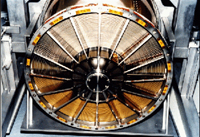XMM-Newton celebrates a golden decade of X-ray astrophysics
10 December 2009
On 10 December 1999 Ariane 504 blasted off from Kourou in French Guiana carrying onboard the European Space Agency's flagship X-ray observatory, XMM-Newton. In the intervening decade this astronomical workhorse has played a significant role in revolutionizing the field of X-astronomy.Today marks a decade of remarkable discoveries, outstanding achievements and extraordinary scientific insights with XMM-Newton. The breadth and scope of the science which has been influenced by this flagship observatory is vast, encompassing, for example, the detection of X-ray emission from solar system objects, detailed studies of star-formation regions, investigation of the formation and evolution of galaxy clusters, probing the environment of supermassive black holes, and mapping dark matter.
 |
This sequence of images indicates just some of the vast range of scientific domains addressed by XMM-Newton, ranging from Solar System science to cosmology. (Click on the image, or follow this link, to read more about these results.) |
These contributions are recorded in an extensive body of scientific literature which is approaching 300 peer-reviewed articles per year. XMM-Newton papers rank consistently in the top ranks of citation measures: a study in 2008 showed that 47% of XMM-Newton articles are amongst the top 10% most cited publications in the literature of the field.
Over the course of the past 10 years XMM-Newton, in tandem with the Chandra X-ray Observatory, has revolutionized the field of X-astronomy. The complementary capabilities of the two X-ray observatories, with superb spectroscopy from XMM-Newton and exquisite imaging from Chandra, have provided X-ray astronomers with the scientific probes required to investigate the physical conditions and mechanisms underpinning the most energetic and violent processes in the Universe.
High quality X-ray spectroscopy for an ESA cornerstone mission
XMM-Newton was accepted into ESA’s Horizon 2000 scientific programme (the precursor to the present Cosmic Vision plan) in 1985 as a cornerstone mission. At that time consultation with the scientific community had identified high quality X-ray spectroscopy and high sensitivity to faint sources as the major next step for X-ray astronomy. By the 1990’s the relatively young field of X-ray astronomy, which began in earnest in 1970 with the launch of the Uhuru satellite, had begun to mature and the number of celestial sources known to emit in X-rays had increased from a few hundred (339 sources at 2-20 keV, detected with the Uhuru satellite) to more than a hundred thousand (150,000 at 0.1-2.5 keV, detected with ROSAT). Advances in technology, for example, the development in Europe of the large area X-ray mirror modules meant that X-ray spectroscopy, a critical diagnostic tool for astrophysics could eventually be implemented.
Six world-class instruments operating in parallel
 |
|
One of the 3 XMM-Newton mirror modules. Credit: ESA |
The XMM-Newton payload comprises 3 co-aligned Wolter Type I grazing incidence gold-coated imaging X-ray telescopes each with an effective area of ~ 1500 cm² @ 1 keV, the largest by far of any X-ray observatory.
The instrument suite is composed of 3 European Photon Imaging Cameras (2 EPIC MOS and 1 EPIC PN), 2 reflection grating spectrometers and an optical monitor. The fact that all six instruments operate in parallel, and the inclusion of an optical monitor, the first on any X-ray observatory, have been key to many of the important discoveries made with XMM-Newton in the past decade. The highly eccentric elliptical orbit of XMM-Newton facilitates long uninterrupted exposures and this, combined with the unprecedented collecting area, has resulted in highly sensitive observations.
More challenging observations, more efficient programmes
The expertise accumulated by the XMM-Newton ground segment (comprising the Mission Operations Centre at ESOC in Germany, the Science Operations Centre at ESAC in Spain, and the Science Survey Centre based in Leicester, UK) in the course of a decade of operating XMM-Newton has allowed the spacecraft and instrument operators to develop more efficient observation schedules and to plan more challenging programmes. This improved efficiency, which stems primarily from a reduction of the time and overhead needed to make observations, and by understanding better the impact of the space environment on the instruments has a direct and positive impact on the science that can be done.
The type of observation that can be planned has also changed with time. The early days were characterised by short observations on well-known, bright X-ray sources, whereas in recent times more challenging observing programmes have been developed which include, for example, observations which must be made at fixed times, longer monitoring programmes and surveys of swathes of the sky. The user demand has remained steady over the course of the decade but a large fraction of the proposals that are being handled are now technically more difficult, and some are pushing the boundaries in terms of science and instrument capabilities.
Looking to the future
As the first decade of XMM-Newton draws to a close, scientists are already preparing for the future. While XMM-Newton has answered many of the questions that it was designed to address, the extraordinary view of the X-ray Universe that it has provided has also raised new questions, such as, how do black holes and matter behave under extreme conditions, can the nature of dark matter and dark energy be constrained by studying the evolution of galaxy formation, and how are chemical elements created and dispersed. The fact that the XMM-Newton spacecraft and instruments are in excellent condition and able to continue to operate for another decade means that this astronomical workhorse is well placed to pursue new challenges. In ten years time, the International X-ray Observatory, IXO, a candidate mission in ESA's Cosmic Vision plan could be ready to take on the challenge of following in the footsteps of XMM-Newton, Europe’s ground-breaking X-ray observatory.
Contact details
Norbert Schartel, ESA XMM-Newton Project Scientist
Email: Norbert.Schartel esa.int
esa.int
María Santos-Lleo, ESA XMM-Newton Science Support Manager
Email: Maria.Santos-LLeo esa.int
esa.int


